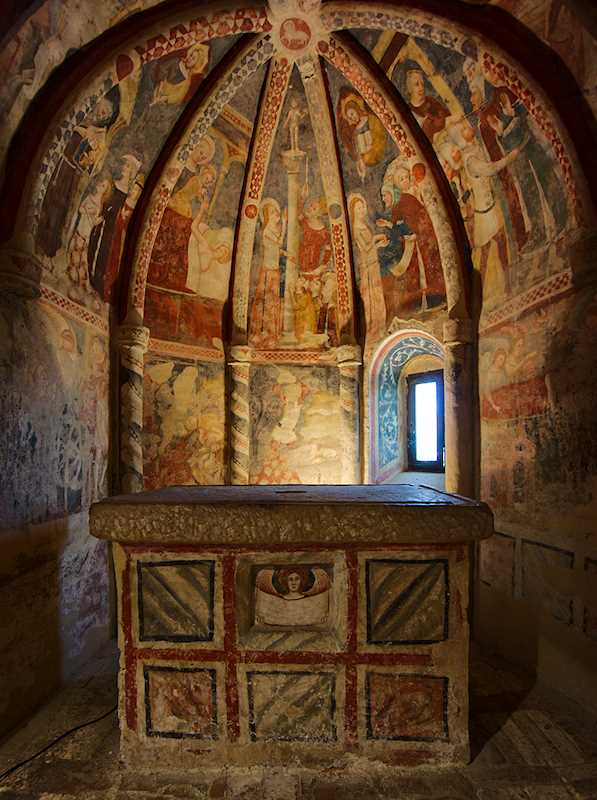Distinctive Pillow Lace, Stunning Frescoes, and a Spectacular Carnival Celebration
If Ascoli Piceno is considered one of Italy’s best-kept secrets (and it truly is), then the charming village of Offida, with a population of just over 5,000, ranks among the country’s top villages. Known for its lace-making tradition, Offida boasts one of Italy’s finest churches, adorned with remarkable frescoes dating back to the 13th century. Just outside the town, some of Italy’s finest and lesser-known white wines are produced. The Piazza al Popolo is adorned with stunning architecture, including an old 19th-century theater, which entertained locals long before the advent of radio. Museums of various kinds, including a dedicated lace museum, are all housed within the same building! Let’s start our journey at Santa Maria della Rocca:
The image above highlights two of Offida’s main attractions: its exquisite lace and breathtaking church frescoes. Here, the delicate shadow of lace graces a crucifixion-themed fresco on the altar. For an explosion of color, take a look at this:

This Romanesque/Gothic church was constructed in 1330 atop an existing Benedictine church. Interestingly, upon entering through the front door, you find yourself in the crypt, with the main church located above.
Strolling along Corso Serpente Aureo, you will discover a shop run by a lace-making association where we filmed a short video demonstrating the creation of the local Merletto a Tombolo, commonly referred to as bobbin or pillow lace in English. The Lace Museum is just down the road, easily marked on the map. We also chatted with an artisan crafting lace at the doorway of her home. Although lace-making is gradually fading, it is still very much alive in Offida.
Located not far from the lace-making shop on Corso Serpente Aureo is a delightful restaurant called Osteria Ophis, which serves local specialties. We opted for the tasting menu and were thoroughly impressed. You may have noticed that “snake” is a recurring theme in the town’s names; il serpente aureo (“golden snake”) often appears in local place names, while the name of the restaurant, ophis, is the Greek term for “snake.” It’s likely that Offida’s name has roots in this word as well.
There are several other churches worth visiting in town; the Chiesa della Collegiata features a fascinating mechanical nativity scene, or presepe. Here’s a glimpse of it:

If you have a car, consider Offida as a day trip destination from Ascoli Piceno, where you should plan to spend at least three days, especially if you’re looking to explore a place that hasn’t yet transformed into a tourist trap.
The highlight of the year is the carnival:
The Offida Carnival unfolds annually according to a detailed schedule: the festivities kick off on January 17, St. Antonio’s Day. The two Sundays before the final week are dedicated to friends and relatives, with carnival parties taking place on Saturday nights at the Serpente Aureo Theatre. The final week, the most important and bustling, starts on Thursday afternoon, traditionally featuring a children’s fancy dress parade in the theatre; Friday is reserved entirely for Lu Bov Fint; Saturday evening hosts the gala party, while Sunday features the masked ball and Monday sees the gathering of the Congreghe inside the theatre. The carnival culminates on Shrove Tuesday with celebrations in the square and the procession of Li Vlurd, which wraps up the festivities on Tuesday evening. ~ The Carnival
For more information about Offida’s Carnival, click here.
Map of Offida’s Location
Disclosure: The following sections contain affiliate links, which provide us with a small commission to help us deliver this content for free.
Where to Stay in Offida
Offida Hotels
Offida Vacation Rentals (Province of Ascoli Piceno)
Quick Guide to Offida Tourism
Don’t miss: the unique Offida Pillow Lace (museum, shop, and artisans creating lace in doorways)
or the Frescoes in Santa Maria della Rocca (as shown in the images above).
Major Events: Carnival, starting January 17. The Lace Week, or La Settimana del Merletto, occurs at the end of June.
Best Times to Visit: Spring or Fall; Summers can be quite hot.
Region: Le Marche Map & Guide
Plan to spend at least one or two days: either 1-2 days, or consider a day trip from Ascoli Piceno to the south.
Train Station: Yes.
Parking: Relatively accessible; refer to the map above for parking locations.
Recommended Restaurant: Osteria Ophis Ristorante
Local Wines: DOCG Pecorino & Passerino (white), Vin Santo (a dessert wine made from Passerino)
More Articles about Destinations in Le Marche
Ascoli Piceno: Forte Malatesta
Le Marche, The Marches
Cartoceto: Le Marche Sublime
Le Marche | Stuzzicchini | July in Italy
Sbaffi – Crafting Sparkling Wine in Le Marche
Silvio Meletti and His Anisetta
Stay in a Roman Battlefield. Eat Well
E78: Paving the Balconies of Piero della Francesca



